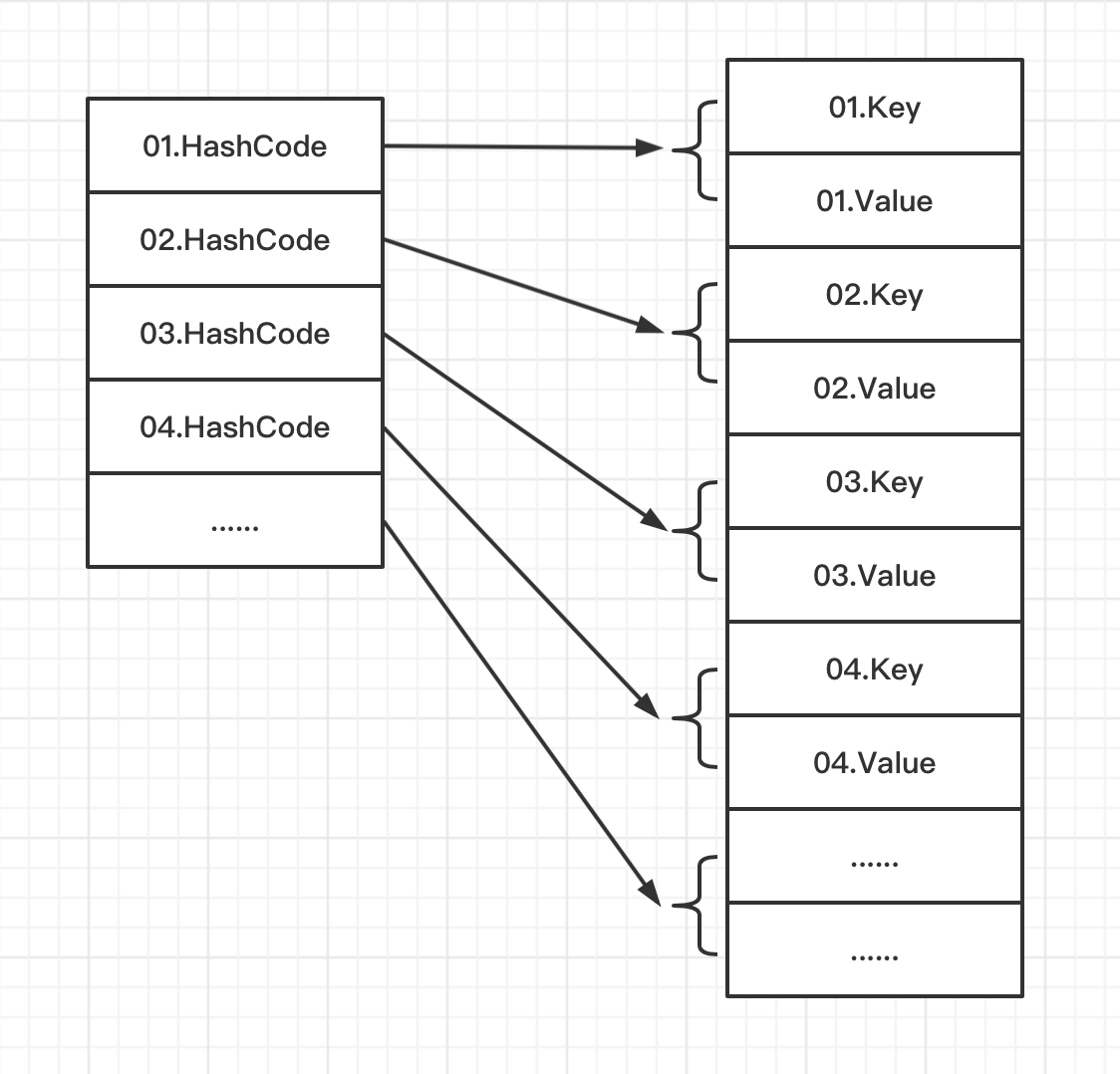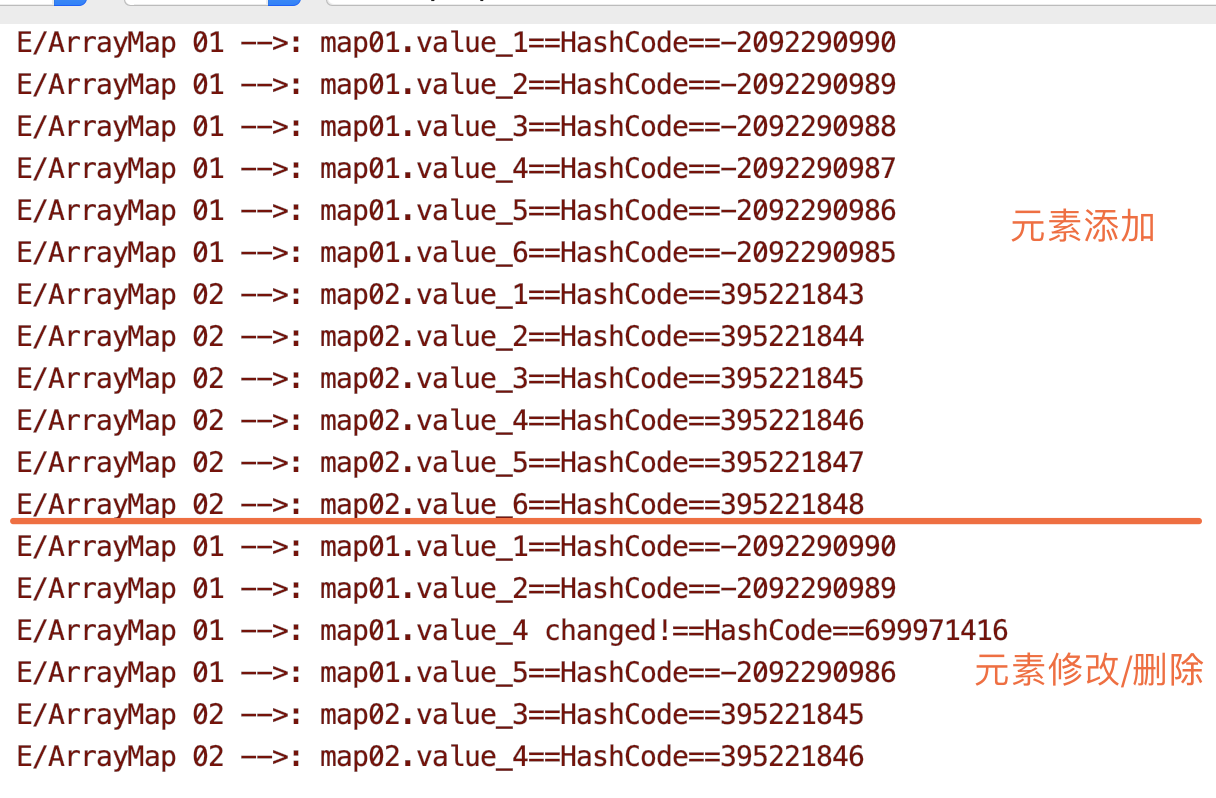小菜在之前学习 SharedPreferences 源码时注意到,其数据存储主要用到了 ArrayMap,小菜在日常中对于 key-value 方式主要是 HashMap 居多,今天简单研究一下 ArrayMap;
ArrayMap
ArrayMap 是一种相较于 HashMap 具有更高内存效率的 key-value 对存储结构;ArrayMap 内部包括两个数组结构,分别是专门用来存储 HashCode 的 mHashes 和用来存储 key-value 的 Object 数组类型的 mArray;
ArrayMap 是非线程安全的;
源码分析
构造函数
public ArrayMap() {
this(0, false);
}
public ArrayMap(int capacity) {
this(capacity, false);
}
public ArrayMap(int capacity, boolean identityHashCode) {
mIdentityHashCode = identityHashCode;
if (capacity < 0) {
mHashes = EMPTY_IMMUTABLE_INTS;
mArray = EmptyArray.OBJECT;
} else if (capacity == 0) {
mHashes = EmptyArray.INT;
mArray = EmptyArray.OBJECT;
} else {
allocArrays(capacity);
}
mSize = 0;
}
ArrayMap 提供了三种构造方法,分别为无参的默认构造函数,添加默认容积的构造函数和一个隐藏的构造函数;若指定容积大小则直接分配相应大小的内存;若是默认构造函数,默认为 0,会在添加数据时动态扩容;
元素查询
int indexOf(Object key, int hash) {
final int N = mSize;
// ====== TAG 01 ======
int index = binarySearchHashes(mHashes, N, hash);
if (index < 0) {
return index;
}
if (key.equals(mArray[index<<1])) {
return index;
}
// ====== TAG 02 ======
for (end = index + 1; end < N && mHashes[end] == hash; end++) {
if (key.equals(mArray[end << 1])) return end;
}
for (int i = index - 1; i >= 0 && mHashes[i] == hash; i--) {
if (key.equals(mArray[i << 1])) return i;
}
return ~end;
}
ArrayMap 查找元素主要是通过 binarySearchHashes 二分查找方式来查找 index;若 HashCode 和 Key 均匹配则为要查找的 index;若只有 HashCode 相同但对象不同(即 HashCode 冲突),则从当前对应的 index 向后和向前分别遍历查找;注意:采用二分查找,则说明 mHashes 数组是有序的;
元素添加
ArrayMap 添加元素的方式主要有 put 和 append 方式;
1. put()
public V put(K key, V value) {
final int osize = mSize;
final int hash;
int index;
if (key == null) {
hash = 0;
index = indexOfNull();
} else {
hash = mIdentityHashCode ? System.identityHashCode(key) : key.hashCode();
// ====== TAG 01 ======
index = indexOf(key, hash);
}
if (index >= 0) {
// ====== TAG 02 ======
index = (index<<1) + 1;
final V old = (V)mArray[index];
mArray[index] = value;
return old;
}
// ====== TAG 03 ======
index = ~index;
if (osize >= mHashes.length) {
final int n = osize >= (BASE_SIZE*2) ? (osize+(osize>>1)) : (osize >= BASE_SIZE ? (BASE_SIZE*2) : BASE_SIZE);
final int[] ohashes = mHashes;
final Object[] oarray = mArray;
// ====== TAG 04 ======
allocArrays(n);
if (CONCURRENT_MODIFICATION_EXCEPTIONS && osize != mSize) {
throw new ConcurrentModificationException();
}
// ====== TAG 05 ======
if (mHashes.length > 0) {
System.arraycopy(ohashes, 0, mHashes, 0, ohashes.length);
System.arraycopy(oarray, 0, mArray, 0, oarray.length);
}
freeArrays(ohashes, oarray, osize);
}
// ====== TAG 06 ======
if (index < osize) {
System.arraycopy(mHashes, index, mHashes, index + 1, osize - index);
System.arraycopy(mArray, index << 1, mArray, (index + 1) << 1, (mSize - index) << 1);
}
mHashes[index] = hash;
mArray[index<<1] = key;
mArray[(index<<1)+1] = value;
mSize++;
return null;
}
小菜在源码处打了几个需要注意的 TAG;
- TAG 01: 主要用于二分查找的方式,在 mHashes 数组中查找 HashCode 值相等的 Key;
- TAG 02: 在 index > 0 即有对应 HashCode 相等的 Key 之后,更新其 Value 值;通过 index << 1 左移的方式相当于 index * 2 只是效率更高效,可多在实际项目中应用;
- TAG 03: 在 index < 0 即没有对应 HashCode 相等的 Key,此时需要插入新数据;
- TAG 04: 当需要扩容时,可采用 allocArrays() 方式分配更大的内存空间;且 ArrayMap 是非线程安全的,不可并行;
- TAG 05: 通过 System.arraycopy 将老的数组数据拷贝到新的数组中,再通过 freeArrays() 释放老的数组内存;
- TAG 06: 当需要插入的元素不在末尾时,拷贝完数据之后需要将 index 后移一位;
2. append()
public void append(K key, V value) {
int index = mSize;
final int hash = key == null ? 0 : (mIdentityHashCode ? System.identityHashCode(key) : key.hashCode());
if (index >= mHashes.length) {
throw new IllegalStateException("Array is full");
}
if (index > 0 && mHashes[index-1] > hash) {
RuntimeException e = new RuntimeException("here");
e.fillInStackTrace();
// ====== TAG ======
put(key, value);
return;
}
mSize = index+1;
mHashes[index] = hash;
index <<= 1;
mArray[index] = key;
mArray[index+1] = value;
}
简单查看 append() 源码,与 put() 相比少了扩容和内存回收等步骤;其两者使用场景不同,append() 无需验证即可将元素追加到数组末尾的特殊快速路径,要求是数组必须足够大;当数据需要插入到数组中间时调用 put() 方式;
元素删除
public V remove(Object key) {
final int index = indexOfKey(key);
if (index >= 0) {
return removeAt(index);
}
return null;
}
ArrayMap 可以通过 remove() 来删除固定元素;首先通过 indexOfKey 二分查找是否有对应要删除的元素,如果有通过 removeAt() 进行删除;
public V removeAt(int index) {
final Object old = mArray[(index << 1) + 1];
final int osize = mSize;
final int nsize;
// ====== TAG 01 ======
if (osize <= 1) {
final int[] ohashes = mHashes;
final Object[] oarray = mArray;
mHashes = EmptyArray.INT;
mArray = EmptyArray.OBJECT;
freeArrays(ohashes, oarray, osize);
nsize = 0;
} else {
nsize = osize - 1;
// ====== TAG 02 ======
if (mHashes.length > (BASE_SIZE*2) && mSize < mHashes.length/3) {
final int n = osize > (BASE_SIZE*2) ? (osize + (osize>>1)) : (BASE_SIZE*2);
final int[] ohashes = mHashes;
final Object[] oarray = mArray;
allocArrays(n);
if (index > 0) {
System.arraycopy(ohashes, 0, mHashes, 0, index);
System.arraycopy(oarray, 0, mArray, 0, index << 1);
}
if (index < nsize) {
System.arraycopy(ohashes, index + 1, mHashes, index, nsize - index);
System.arraycopy(oarray, (index + 1) << 1, mArray, index << 1, (nsize - index) << 1);
}
} else {
// ====== TAG 03 ======
if (index < nsize) {
System.arraycopy(mHashes, index + 1, mHashes, index, nsize - index);
System.arraycopy(mArray, (index + 1) << 1, mArray, index << 1, (nsize - index) << 1);
}
mArray[nsize << 1] = null;
mArray[(nsize << 1) + 1] = null;
}
}
mSize = nsize;
return (V)old;
}
- TAG 01: 当数组只有一个要删除的元素时,直接将 mHashes 和 mArray 置空并通过 freeArrays 释放内存即可;
- TAG 02: 当数组内存大小大于 8 并且元素数量少于 1/3 空间大小时,通过 allocArrays 进行减少内存分配,将老数据拷贝到新的数组中,并清空老数据数组空间;这是 HashMap 不曾实现的;
- TAG 03: 当删除其中一个元素时,需要将该元素之后的所有元素向前移动一位;
数组扩容
HashMap 直接以容积的 2 倍进行扩容,而 ArrayMap 数组扩容是分阶段扩容的;与基础数组长度有关;
final int n = osize >= (BASE_SIZE*2) ? (osize+(osize>>1)) : (osize >= BASE_SIZE ? (BASE_SIZE*2) : BASE_SIZE);
- 当 osize >= 8 时,数组扩容为原来的 1.5 倍;其中 osize >> 1 相当于 osize / 2;
- 当 4 <= osize < 8 时,此时扩展为 8;
- 当 osize < 4 时,此时扩展为 4;
内存机制
// ArrayMap 扩容的最小容积(用于调整为相对节省空间方式)
private static final int BASE_SIZE = 4;
// 最大缓存数组数
private static final int CACHE_SIZE = 10;
// 用来缓存 BASE_SIZE = 4 的数组内容
static Object[] mBaseCache;
// mBaseCache 缓存的数量
static int mBaseCacheSize;
// 用来存储 BASE_SIZE * 2 = 8 的数组内容
static Object[] mTwiceBaseCache;
// mTwiceBaseCache 缓存的数量
static int mTwiceBaseCacheSize;
ArrayMap 为了避免频繁的创建和销毁,提供了 mBaseCache 和 mTwiceBaseCache 两个数组缓冲池,同时提供了 allocArrays 和 freeArrays 内存分配和释放的方法,两者相互对应,都通过缓冲池分配和释放内存;
private void allocArrays(final int size) {
if (size == (BASE_SIZE*2)) {
synchronized (ArrayMap.class) {
if (mTwiceBaseCache != null) {
final Object[] array = mTwiceBaseCache;
mArray = array;
mTwiceBaseCache = (Object[])array[0];
mHashes = (int[])array[1];
array[0] = array[1] = null;
mTwiceBaseCacheSize--;
return;
}
}
} else if (size == BASE_SIZE) {
...
}
mHashes = new int[size];
mArray = new Object[size<<1];
}
当需要分配内存大小为 BASE_SIZE 或 BASE_SIZE * 2 时,会先查看对应的缓存池中取出 mArray 和 mHashes;其方式是先将缓存池指向上一条缓存地址,将缓存池的第 array[1] 个元素赋值为 mHashes ,再把 mArray 的第 array[0] 和第 array[1] 个位置的数据置为 null;
private static void freeArrays(final int[] hashes, final Object[] array, final int size) {
if (hashes.length == (BASE_SIZE*2)) {
synchronized (ArrayMap.class) {
if (mTwiceBaseCacheSize < CACHE_SIZE) {
array[0] = mTwiceBaseCache;
array[1] = hashes;
for (int i=(size<<1)-1; i>=2; i--) {
array[i] = null;
}
mTwiceBaseCache = array;
mTwiceBaseCacheSize++;
}
}
} else if (hashes.length == BASE_SIZE) {
...
}
}
当内存需要释放时,释放大小为 BASE_SIZE 或 BASE_SIZE * 2 时,会将数组加入到缓冲池中;其方she式是先将原缓冲池和哈希数组分别指向 array 前两位,之后的元素全部置空,最后将缓存池的头部指向最新的数组位置;
注意事项
ArrayMap 不适合大量的数据结构,Google 建议在 1000 以内的数据量比较好;ArrayMap 内部采用了二分查找方式查询,时间复杂度 O(logN),每次添加和删除元素都需要移动其后面的元素,速度相对较慢;而 HashMap 查找和删除时间复杂度为 O(1);
ArrayMap 相对于 HashMap 增加了内存缓存策略,避免频繁创建对象而分配内存与 GC 操作,同时限制了缓冲池的上限(10 个);与此同时,ArrayMap 还提供了灵活的扩容和缩容机制,这两种机制比 HashMap 更灵活且节省时间;
ArrayMap 还解决了 HashMap 稀疏数组的问题,相对占用内存更少;
案例尝试
ArrayMap map01 = new ArrayMap();
ArrayMap map02 = new ArrayMap(4);
// 元素添加
for (int i = 0;i < 6;i ++) {
map01.put("index_"+(i+1), "map01.value_"+(i +1));
map02.put("index_"+(i+1), "map02.value_"+(i +1));
}
for(int i = 0 ;i < map01.size();i ++){
Log.e("ArrayMap 01 -->", map01.get("index_"+(i+1)).toString()+"==HashCode=="+map01.get("index_"+(i+1)).hashCode());
}
for(int i = 0 ;i < map02.size();i ++){
Log.e("ArrayMap 02 -->", map02.get("index_"+(i+1)).toString()+"==HashCode=="+map02.get("index_"+(i+1)).hashCode());
}
// 元素删除
map01.remove("index_3");
// 元素修改
map01.put("index_4", "map01.value_4 changed!");
map02.remove("index_1");
map02.remove("index_2");
for(int i = 0 ;i < map01.size();i ++){
if (map01.get("index_"+(i+1)) != null) {
Log.e("ArrayMap 01 -->", map01.get("index_" + (i + 1)).toString() + "==HashCode==" + map01.get("index_" + (i + 1)).hashCode());
}
}
for(int i = 0 ;i < map02.size();i ++){
if (map02.get("index_"+(i+1)) != null) {
Log.e("ArrayMap 02 -->", map02.get("index_" + (i + 1)).toString() + "==HashCode==" + map02.get("index_" + (i + 1)).hashCode());
}
}
小菜对 ArrayMap 的源码了解还不够深入,与其他存储方式的横向对比也不够全面;如有错误请多多指导!
> 来源: 阿策小和尚
共同学习,写下你的评论
评论加载中...
作者其他优质文章







